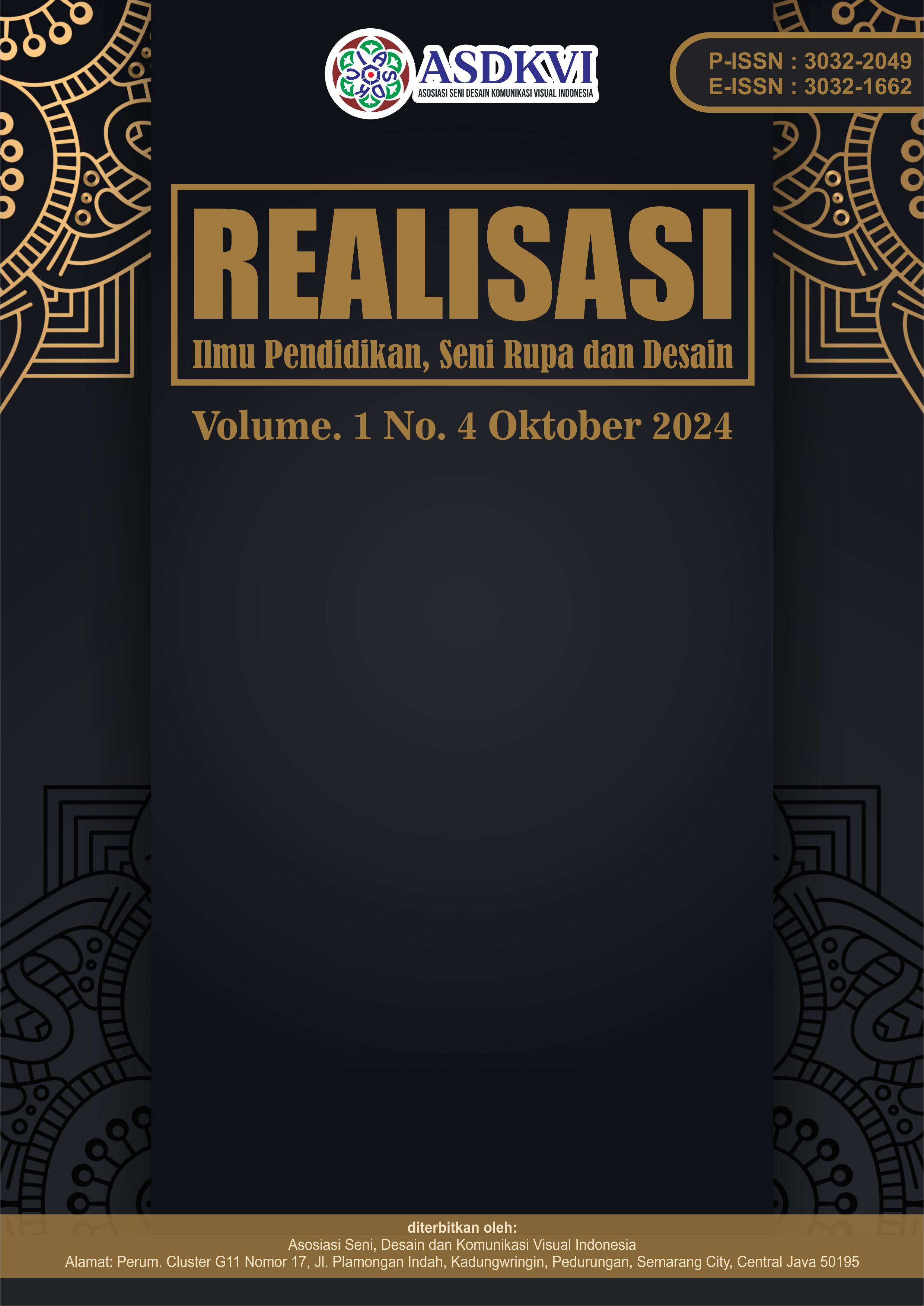Bonsai Sebagai Ide Karya Seni Lukis Surealistik
DOI:
https://doi.org/10.62383/realisasi.v1i4.320Keywords:
Bonsai, Painting, SurrealisticAbstract
This work aims to visualize various issues related to insomnia. It reflects the author's concern about how insomnia disrupts human activity and physical health. The creation of this artwork explores how to translate the concept of insomnia into figurative abstract painting. The methods and processes used in creating this abstract figurative artwork involve several stages: (1) Preparation, (2) Elaboration, (3) Synthesis, (4) Concept Realization, and (5) Completion. The technique employed is acrylic on canvas. The result of this work, visualized on a two-dimensional medium, has led to the development of titles such as “Keseimbangan” (Balance), “Kasih Sayang” (Affection), “Dedikasi Orang Tua” (Parental Dedication), “Pilihan” (Choice), “Cinta Pertama” (First Love), “Kampak Pertahanan” (Defense Axe), “Pistol Kehidupan” (Life Pistol), “Rumah Rantau” (Home Away), and “Sajian Bonsai” (Bonsai Presentation).
References
Andriadi, M. (2015). Permasalahan gigi dalam ungkapan karya seni patung (Laporan karya akhir). Program Pendidikan Seni Rupa, Universitas Negeri Padang.
Arnheim, R. (1974). Art and perception: A psychology of the creative eye. University of California Press.
Bundon, F., Prusinkiewicz, P., Federl, P., Gpdin, C., & Karwowski, R. (2003). Interactive design of bonsai tree models. Computer Graphics. Retrieved July 3, 2023, from [URL not provided].
Cash, D., Hofheinz, D., Kiltz, E., & Peikert, C. (2010). Bonsai trees or how to delegate a lattice basis. In Lecture Notes in Computer Science (Vol. 6110 LNCS, pp. 523-552). https://doi.org/10.1007/978-3-642-13190-5_27. Retrieved July 3, 2023, from [URL not provided].
Dharsono, & Prawira, N. G. (2003). Pengantar estetika dalam seni rupa. Diknas.
Dharsono. (2003). Tinjauan seni rupa modern. Surakarta.
Dwilestari, S., & Nurmiati, S. (2018). Sistem pakar penentuan style pada tanaman bonsai menggunakan metode certainty factor. Jurnal Teknologi Informasi, 28(2), 49-56.
Ernis, L. W., & Pebriyeni, E. (2012). Bahan ajar nirmana 2 (Unpublished manuscript). Fakultas Bahasa dan Sastra, Universitas Negeri Padang.
Ferdinand, A. (2009). Dasar-dasar ekologi tumbuhan. Penerbit Ilmu Alam.
Hagwood, S. (n.d.). Kekuatan memori: Mengembangkan kemampuan memori menjadi luar biasa. Cinta Buku.
Jurnal Unimed. (2012). Retrieved from https://jurnal.unimed.ac.id/2012/index.php/jgkp/article/download/14587/11943
Kartika, D. S. (2004). Seni rupa modern. Rekayasa Sains. [Note: Reference to Rochmatuloh's final report is not included as it is not a standard source type for APA.]
KBBI Kemdikbud. (n.d.). Bonsai. Retrieved from https://kbbi.kemdikbud.go.id/entri/bonsai
Leman. (2007). The best of Chinese life philosophies. Ikrar Mandiri Abadi.
Marianto, M. D. (2017). Art & life force in a quantum perspective. Scritto Books Publisher.
Mokodompit, R., Kandowangko, N. Y., & Hamidun, M. S. (2022). Keanekaragaman tumbuhan di kampus Universitas Negeri Gorontalo Kecamatan Tilong Kabila Kabupaten Bone Bolango. BIOSFER: Jurnal Biologi dan Pendidikan Biologi, 7(1), 75-80.
Orr, S. (2009). Not all trees are cut out to be bonsai. The New York Times. Retrieved from http://www.nytimes.com/2009/02/26/garden/26qna.html
Salam, S., Sukarman, H., & Muhaimin, M. (2020). Pengetahuan dasar seni rupa. Media Sembilan Sembilan.
Soedarso, Sp. (2000). Sejarah perkembangan seni rupa modern. Studio Delapan Puluh.
Sri Ipnuwati, K., & Aditama, K. (2020). Penerapan metode Technique For Others Reference By Similarity To Ideal Solution (TOPSIS) dalam pemilihan tanaman bonsai terbaik. Jurnal Explore, 11(1). http://u.lipi.go.id/1566543306. https://doi.org/10.36448/jsit.v11i1.1457. Retrieved May 9, 2023, from [URL not provided].
Downloads
Published
How to Cite
Issue
Section
License
Copyright (c) 2024 Realisasi : Ilmu Pendidikan, Seni Rupa dan Desain

This work is licensed under a Creative Commons Attribution-ShareAlike 4.0 International License.





